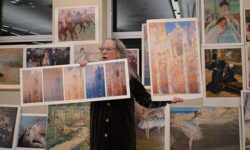By Audrey Anderson
Hometown Weekly Reporter
In case you weren’t aware, there will be a total solar eclipse on April 8, 2024! There won’t be another one until August 3, 2044. At the Walpole Public Library on Thursday, March 14, award-winning photographer Silvana Della Camera shared important information and tips on viewing and photographing the upcoming eclipse.
Della Camera said she is concerned that many people damaged their eyesight during the last eclipse in 2017. Her concern for safety is one of the motivations for her presentation. Your camera sensor is also at risk of damage, and you must use the proper equipment to protect it.
According to Della Camera, planning is key when attempting to photograph a solar eclipse. You will have to determine where to position yourself to get the best viewpoint and the longest duration. You might have to travel for several hours to get to the best spots. She recommended using the following references to gather information on the best viewing areas, watch the cloud forecast, and find the longest eclipse duration:
• Sky and Telescope (https://skyandtelescope.org/total-solar-eclipse)
• timeanddate.com
• Eclipse2024.org
• Astropheric app for cloud forecast
Have backup plans, including refundable accommodations booked in several of the best viewing locations. Thousands of people will congregate to watch and photograph the eclipse. Weather conditions change. Hotel rooms are going fast. There will be traffic jams and people lining the highways with photography setups. You will have to get a good spot.
To protect your eyes, wear ISO-certified eye shades (not sunglasses) to view the eclipse. The best ones have plastic frames, which are much more reliable than those made of cardboard. Without effective protection, you would be at risk of burning your retinas. When wearing the proper eye shades, you can safely look directly at the eclipse.
Do not look through the viewfinder on your DSLR camera, as doing so will also put you at risk of burning your retinas. To protect your eyesight, put gaffer tape over your viewfinder, in case you accidentally try to look through it. Instead, use the live view on the back of your camera.
If you have a mirrorless camera, it is okay to look through the viewfinder, due to the difference in the internal mechanism in that type of camera.
You must also consider protecting your camera’s sensor. You will need to use a special solar filter over your lens. There are both mylar and glass solar filters available. A glass filter is best used with a magnetic holder, rather than screwing it into your lens. This way the filter can be removed easily during totality and quickly replaced before totality ends. Solar filters are also available for cell phone cameras.
Do not use stacked neutral density (ND) filters, polarized filters, or any other kind of filters other than mylar or glass solar filters.
Use a sturdy tripod to steady your camera. A gimble head is better than a ball head for solar photography, as it allows you to get the best positions for your lens more easily.
If you would like to create a composite image that includes several stages of the eclipse, you can use the above suggested web sites and application for information. An intervalometer with a remote shutter trip and/or a sun tracker is helpful. You can also use the web sites and apps to determine which lens to use for different amounts of foreground in your resulting photos or to gauge how many photos you will take during the duration of eclipse. You will have to plan to bring a power supply, fully charged batteries, and a large enough card(s) to hold all of the photos.
The only time you can view the sun’s beautiful corona is during totality. At this point, carefully watching the time, you can remove your solar filter to photograph the corona. Be sure to replace the solar filter before totality is complete.
Silvana Della Camera is an award-winning photographer serving New England and beyond. She concentrates on astral photography and lighthouses, and also offers photography classes and tours, and creates portraits for her clients. Her images have appeared in “Lighthouse Digest,” “Yankee Magazine,” and the “Boston Globe,” and they were featured in Nikon’s 100th birthday celebration. She is a master member of the New England Camera Club and a member of the Professional Photographers Association. See https://silvanadellacamera.com/.






















